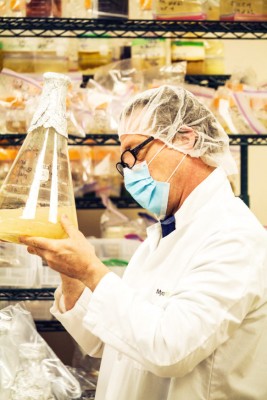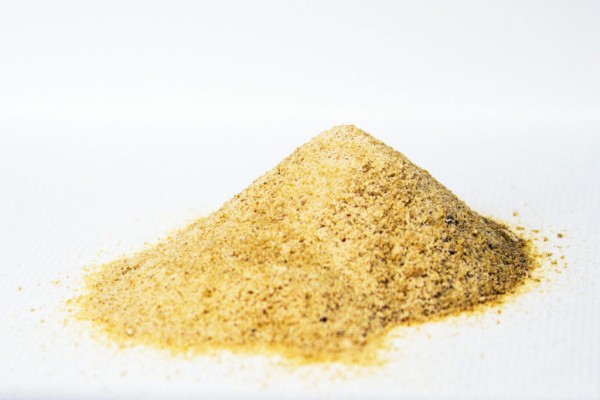A Magical Mushroom Powder Blocks Bitterness in Food

“I ACTUALLY HATE the taste of mushrooms,” says Josh Hahn, as he flicks on the lights in the clean room. Which is funny, because Hahn’s livelihood depends on fungi. Here, inside the lab at the biotechnology startup MycoTechnology, a few dozen Erlenmeyer flasks slowly gyrate on shake tables. They’re filled with a liquid the color and consistency of cloudy bone broth, a slurry of growth media and, yep, mushrooms. Or, to be more precise, mycelia: the thread-like strands that make up fungal colonies and produce mushrooms but that humans rarely see because they’re below ground.
In its Aurora, Colorado production facility, MycoTechnology is fermenting mycelia, later blast-drying them into an odorless, tasteless powder called ClearTaste—what marketing manager Hahn would call “the world’s first organic universal bitter blocker.” Not a black coffee drinker? You could be with just a tiny sprinkle of the stuff. It works on the molecular level, bonding to taste receptors on your tongue and blocking signals to your brain that translate to perceiving bitterness. Such a substance could have big implications for the health of the United States’ sugar-addicted society. But like all food additives, it has its mysteries—and no one is sure exactly what your body does with it once it’s inside.
ClearTaste isn’t the only bitter blocker on the market, but it’s the only one that claims to be universal. There’s a good reason no one has done that yet—bitterness is a notoriously elusive taste to commandeer. Your tongue is littered with 25 kinds of bitter receptors (called T2Rs) that are triggered by thousands of different molecules. An aversion to bitterness is a kind of gustatory flare gun: Some of those thousands of compounds are toxic, so the tongue needs a wide range of receptors to detect them.
With so many redundancies, it’s a tricky system to override. The world’s largest flavor companies have been throwing money at the problem for more than a decade, and have little to show for it. There are currently 13 known bitter blockers, all synthetic chemicals discovered using multi-million dollar high-throughput assays. Most can only bind to one or two receptors. The best top out around 10. Keeping bitter flavors out of America’s food supply has required adding these chemical blockers in multiples—and when that fails, masking them with a boatload of sugar.
A Spoonful of Mycelium
Which is why ClearTaste has gotten so much attention from the food industry. It promises to reduce the sugar content of all your favorite foods by 50 to 90 percent. With sugar on the White House’s shit list and consumers clamoring for healthier options, food companies are eager for a simple solution.
ClearTaste is already in some US foods, thanks to a partnership with alternative sweetener producer GLG Life Tech Corp. And with GLG’s recent inking of a deal with food giant Archers Daniel Midland (makers of ubiquitous ingredients like oils, starches, flours, and cocoa powder), it’s slated to show up more and more. “We’re currently in talks with every major food company in the world,” says Hahn.
But don’t expect to see it on food labels any time soon. You need such a small amount that it likely won’t be showing up on any ingredient lists. And because MycoTechnology sells directly to flavoring companies that have NDAs with their partners, not even the makers of ClearTaste will know who has it.
This raises flags with groups like the Center for Food Safety, which are concerned the product will be used to market to children sensitive to bitter tastes. “Just because something comes from yeast or a mushroom doesn’t make it automatically safe,” says the Center’s senior policy analyst Jaydee Hanson. “It should still go through the whole testing process that any food additive would.” ClearTaste is FDA-approved under Generally Regarded As Safe status, because mycelia have been in supplements for decades.
Even though they didn’t have to jump over food additive regulatory hurdles, MycoTechnology’s scientists have been trying to understand how ClearTaste interacts with the mouth (they submitted their first peer-reviewed paper in July). But they haven’t looked at what happens after you swallow—which is where it starts to really get interesting.
Down the Chain
Those bitter receptors, the T2Rs, don’t just show up on your tongue. They’re also in your gut, your lungs, and your brain. Scientists aren’t sure why we have T2Rs in these other tissues, and they’re just starting to figure out how they work. In the lungs, for example, they’re involved with the relaxing and constricting of the airways and show promise for the treatment of asthma. In the gut, bitter compounds bind to T2Rs and stimulate the release of peptides that tell our stomach walls how hard to contract, our intestinal cells how well to absorb nutrients, and our brains how full we feel.
In 2015, researchers from Belgium saw substantial changes in mice when bitter substances were put directly into their stomachs. Obese mice lost a significant amount of weight over the course of a month, while normal mice ate less and their stomachs emptied slower. When scientists repeated the experiment in humans, subjects who got the bitter treatment felt satiated earlier and absorbed fewer calories. In each experiment, it was the T2Rs that mediated the observed changes. Scientists have hypothesized that blocking the receptors’ ability to send signals could have direct effects on gut function.
Others say there’s not enough data to predict what would happen down there. “It’s very complex and difficult to say what the effect of an antagonist will be,” says Prashen Chelikani, director of the Manitoba Chemosensory Biology Research Group. “But we do know that blocking won’t have the same effect in different tissues. And if the efficacy of the blocker is high it will shut down multiple pathways.”
Mounting evidence indicates that bitterness is more than just a bad taste to be blocked. It’s an essential component of digestion and metabolism, without which who knows how many dark chocolate bars or pints of West-Coast hopped IPAs you might put down. And sure, with ClearTaste, they’d be low in sugar, which is a good thing. But it’s also important to consider what happens after we take that perfect, bitter-free bite. Because sometimes when you play tricks on your senses, you learn later the joke was on you all along.













